Blanched gai lan, also known as Chinese broccoli, is a staple in Cantonese cuisine celebrated for its vibrant green hue, crisp texture, and delicate balance of flavors. This dish, often served as a side or appetizer, highlights the natural sweetness of the vegetable while incorporating a savory-sweet sauce that elevates its simplicity. Whether you’re a seasoned home cook or a novice in the kitchen, mastering the technique of blanching gai lan ensures a restaurant-quality dish that pairs beautifully with rice, noodles, or grilled proteins. In this comprehensive guide, we’ll explore the history of gai lan, the science behind blanching, and the precise steps to achieve perfection every time.
What Is Gai Lan?
Gai lan (Brassica oleracea var. alboglabra) is a leafy green vegetable native to Southeast Asia. With thick, crunchy stems and glossy, dark green leaves, it resembles a hybrid of broccoli and kale. Unlike its Western counterparts, gai lan has a mild bitterness that mellows when cooked, making it a versatile ingredient in stir-fries, soups, and braises. However, blanching—a cooking method that involves brief immersion in boiling water followed by rapid cooling—is the most popular way to prepare gai lan, as it preserves its vibrant color, nutrients, and crisp texture.
The Science of Blanching
Blanching serves dual purposes: it partially cooks the vegetable while halting enzyme activity that can lead to spoilage or loss of color. For gai lan, this process is critical. Overcooking results in mushy stems and dull, olive-green leaves, while undercooking leaves the vegetable raw and fibrous. The key lies in timing and temperature control.
- Boiling Water: A large pot of rapidly boiling water ensures even cooking. The high heat quickly softens the stems without overcooking the leaves.
- Ice Bath: Shocking the blanched gai lan in ice water stops the cooking process immediately, locking in color and crispness.
Ingredients You’ll Need
To serve 4 people, gather the following:
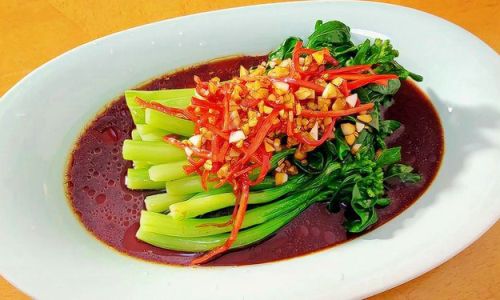
- 1 pound fresh gai lan (look for firm stems and perky leaves; avoid wilted or yellowing produce)
- 1 tablespoon neutral cooking oil (such as vegetable or canola oil)
- 3 garlic cloves, minced (or 1 tablespoon garlic-infused oil for a milder flavor)
- 2 tablespoons oyster sauce (or vegetarian oyster sauce for a plant-based alternative)
- 1 tablespoon soy sauce (light soy sauce for saltiness, dark for richness)
- 1 teaspoon sesame oil
- 1 teaspoon sugar (optional, to balance bitterness)
- 1/4 cup low-sodium chicken broth (or water for a lighter version)
- 1/2 teaspoon cornstarch (mixed with 1 tablespoon water to thicken the sauce)
- 1/4 teaspoon white pepper (or black pepper, if preferred)
- 2 tablespoons fried garlic chips (optional garnish)
- 1 red chili, thinly sliced (for color and heat)
- 1 tablespoon toasted sesame seeds (for texture)
Step-by-Step Preparation
Preparing the Gai Lan
- Trimming: Rinse the gai lan under cold water to remove dirt. Using a sharp knife, trim 1/4 inch from the base of the stems. If the stems are thick (thicker than a pencil), slice them lengthwise into quarters to ensure even cooking.
- Separating Leaves and Stems: While optional, separating the leaves from the stems allows for precise blanching. Add the stems to the boiling water first, as they take longer to cook, then the leaves.
Blanching the Vegetable
- Boil Water: Fill a large pot with water (at least 6 quarts) and bring it to a rolling boil. Add 1 tablespoon of salt to enhance flavor.
- Blanch Stems: Add the gai lan stems to the boiling water. Cook for 1 minute if sliced, or 2 minutes if whole.
- Add Leaves: Submerge the leaves and cook for an additional 30 seconds. The leaves should wilt slightly but retain their bright green color.
- Ice Bath: Immediately transfer the blanched gai lan to a bowl of ice water. Let it chill for 2-3 minutes, then drain thoroughly. Pat dry with a clean kitchen towel to prevent dilution of the sauce.
Crafting the Sauce
The sauce is the soul of the dish, balancing umami, sweetness, and heat.
- Sauté Aromatics: Heat the cooking oil in a wok or skillet over medium heat. Add the minced garlic and stir-fry until golden (30 seconds). Reduce heat if the garlic begins to brown to avoid bitterness.
- Combine Liquids: Add the oyster sauce, soy sauce, sesame oil, sugar (if using), and chicken broth. Stir until the sugar dissolves.
- Thicken: Pour in the cornstarch slurry and cook for 1-2 minutes, stirring gently, until the sauce thickens slightly. Adjust seasoning with white pepper.
Assembling the Dish
- Arrange: Place the blanched gai lan on a serving platter, arranging it neatly to showcase the vibrant green.
- Sauce: Drizzle the sauce evenly over the gai lan. For a restaurant-style finish, use a spoon to create decorative swirls.
- Garnish: Sprinkle with fried garlic chips, sliced chili, and toasted sesame seeds. The garnishes add crunch, aroma, and visual appeal.
Tips for Perfection
- Uniformity: Ensure the gai lan is trimmed to the same size for even cooking.
- Water Quality: Use fresh water for blanching to avoid off-flavors.
- Sauce Consistency: Adjust the cornstarch amount based on your preference—more for a glossy finish, less for a thinner sauce.
- Heat Control: Overcooking the garlic will make it bitter; stir-fry it just until fragrant.
Variations and Substitutions
- Vegetarian Option: Replace oyster sauce with mushroom-flavored soy sauce or hoisin sauce.
- Spice Level: Add a teaspoon of chili oil or Sriracha to the sauce for heat.
- Protein Boost: Toss in cooked shrimp or tofu during the sauce-making step.
- Gluten-Free: Use tamari instead of soy sauce and ensure the oyster sauce is gluten-free.
Troubleshooting Common Issues
- Mushy Gai Lan: Overblanching is the culprit. Test doneness by piercing the stem with a knife—it should offer slight resistance.
- Bland Flavor: Increase the soy sauce or add a pinch of salt. A splash of rice vinegar can also brighten the dish.
- Oily Sauce: Use a slotted spoon to drain excess oil before serving.
Health Benefits of Gai Lan
Gai lan is a nutritional powerhouse, rich in:
- Vitamins A, C, and K: Essential for immune function, skin health, and blood clotting.
- Fiber: Aids digestion and promotes satiety.
- Antioxidants: Combats inflammation and oxidative stress.
- Calcium and Iron: Supports bone health and red blood cell production.
Blanching retains more nutrients than frying or prolonged boiling, making this dish a healthy addition to any meal.
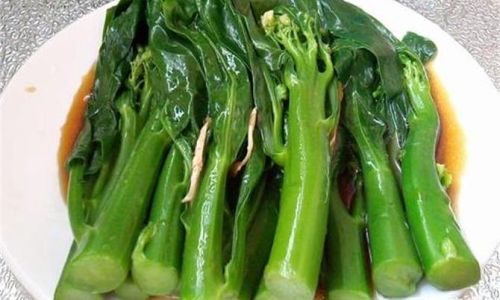
Serving Suggestions
- With Rice: Pair with jasmine rice and a drizzle of sauce for a comforting meal.
- As Part of a Banquet: Serve alongside dim sum, roasted duck, or steamed fish.
- In Noodle Bowls: Toss with chow mein noodles and grilled chicken for a quick dinner.
- With Dipping Sauce: Offer a side of chili oil or black vinegar for extra zing.
Cultural Significance
In Chinese culture, gai lan symbolizes prosperity and longevity, often featured during Lunar New Year celebrations. Its vibrant green color represents renewal, while its crisp texture mirrors the desire for vitality. The dish’s simplicity also reflects Confucian ideals of balance and harmony—a philosophy embedded in Cantonese cooking.
Conclusion
Blanched gai lan is more than a side dish; it’s a testament to the art of minimalism in cooking. By mastering the blanching technique and balancing flavors, you transform a humble vegetable into a culinary masterpiece. Whether you’re hosting a dinner party or cooking a weeknight meal, this dish delivers elegance with ease. Experiment with garnishes, adjust the sauce to your liking, and savor the satisfaction of creating a restaurant-quality plate at home. Remember, the key to perfection lies not in complexity, but in precision—and a pinch of patience.
Now, grab your apron, heat the wok, and let the aroma of garlic and sesame fill your kitchen. Your journey to blanched gai lan mastery begins here.
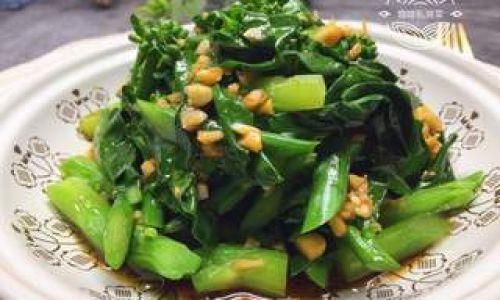
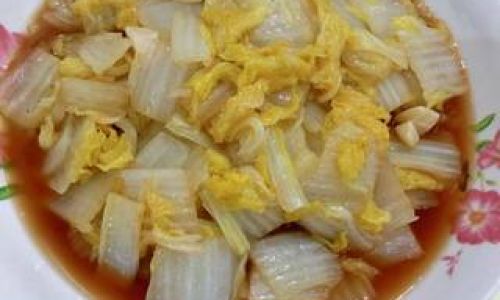
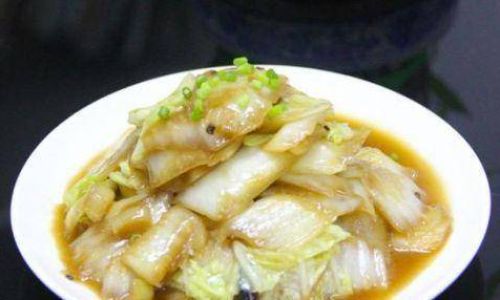
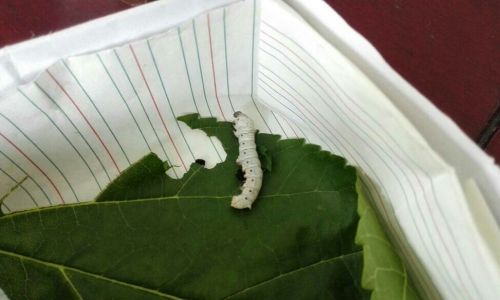

0 comments